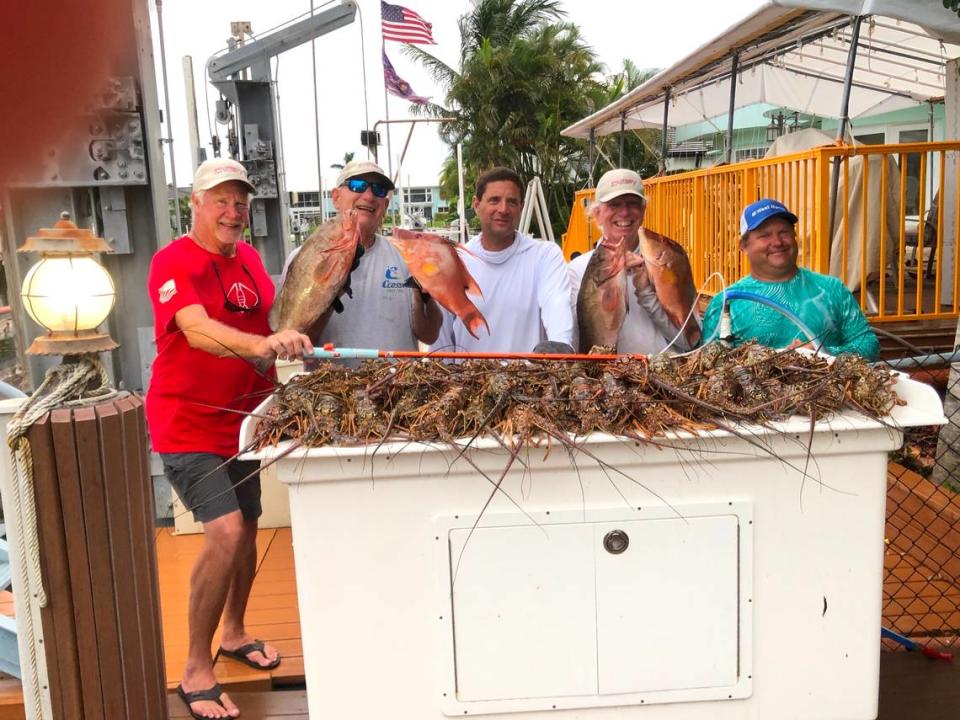‘Christmas came early’ as lobster divers receive an extra day (July 14) of diving
South Florida lobster hunters look forward to the annual two-day miniseason, which is the last consecutive Wednesday and Thursday in July. That’s when divers get their first chance at catching the key ingredients for several tasty dinners since the regular lobster season closed on April 1.
But this year Florida residents get an extra day of miniseason. Gov. Ron DeSatis announced last month that as part of a $57 million coral reef restoration and coastal protection initiative, the lobster miniseason will include July 14, exclusively for Florida residents. The regular miniseason is July 24-25.
“Christmas came early!” said Jim “Chiefy” Mathie of Deerfield Beach, author of “Catching the BUG: The Comprehensive Guide to Catching the Spiny Lobster,” a how-to book on hunting for lobsters that is available at many local dive shops and online.
“Adding an additional day on a Sunday before the normal miniseason for Florida residents will be a real shot in the arm for the dive industry. Dive charters and shops are already seeing an increase in demand, which will be a great economic benefit.”
Getting in the water before July 14 is now a priority for many divers. The popularity of the miniseason makes safety a critical concern, primarily because many scuba divers have not been in the water since last year’s miniseason. Their diving skills might be rusty, along with their dive gear. Cracked hoses that leak air and mask and fin straps that are on the verge of tearing can endanger a diver’s life.
That’s why it’s a good idea to go diving before the miniseason. Getting reacquainted with being under the water is also an opportunity to scout for lobsters. If your equipment needs to be repaired or replaced, now is the time to do that rather than waiting until a few days before the miniseason.
I’ll never forget a pre-miniseason dive with Mathie. We were scouting for lobsters and water kept getting into my dive mask. I cleared the water repeatedly, and thought that maybe my mask strap wasn’t tight enough.
On about the 10th time I cleared my mask, one of the lenses in my mask came loose in my hand. I turned to Mathie, who is a retired fire chief, extremely safety conscious and a great dive buddy. He instantly recognized what was going on and guided my back to the surface while I kept my eyes closed.
Back in his boat, we saw that the frame holding my lenses in place was cracked, which is why water kept seeping into the mask. Fortunately Mathie had another mask on his boat, so I was able to keep diving. When miniseason arrived, I went diving with an older mask of mine while the cracked mask was being repaired by the manufacturer.
The absence of commercial lobster traps and not being poked and prodded by divers armed with snares, tickle sticks and nets for nearly four months usually results in an abundance of crustaceans for the miniseason that are less wary than normal.
As if that isn’t enough of a reason to go diving for bugs, as they are known because of their insect-like appearance, the daily bag limit in Miami-Dade, Broward and Palm Beach counties is 12 lobsters per person. That’s double the limit during the regular season, which opens Aug. 6.
The miniseason is more restrictive in the Florida Keys, where the daily limit is six bugs and no diving is allowed at night. The reason is to reduce, hopefully, the number of divers who descend on the Keys, where spiny lobsters are typically more plentiful, especially in the shallow waters surrounding the island chain. Many lobster hunters catch them in six to 10 feet of water using only a mask, fins and snorkel. Visit www.myfwc.com/fishing/saltwater/recreational/lobster for current lobster regulations.


